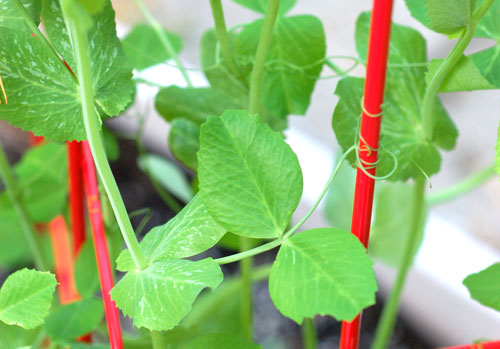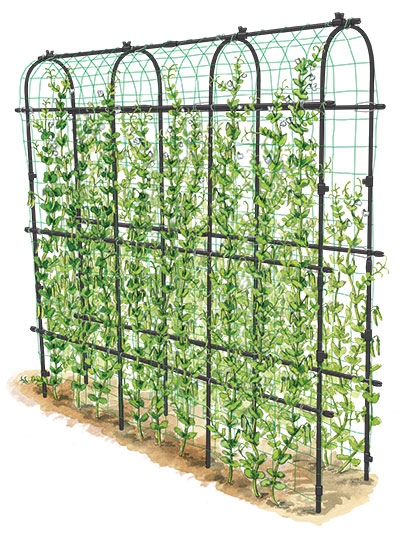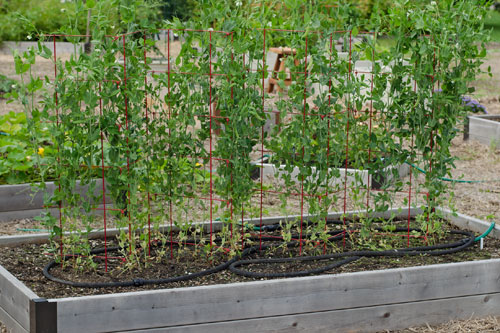Peas
 Peas climb by using tendrils, which can encircle any support that's less than a quarter inch.
Peas climb by using tendrils, which can encircle any support that's less than a quarter inch.Peas are are one of the first things you can plant in the spring, but getting the timing right is tricky. Plant too early and your peas may be stunted by cold soil and frost. Plant too late and your plants may start to shrivel up from the heat just as you get ready to start picking peas.
When to plant
Pea seeds germinate slowly in cold soil, so you may want to cover the planting area with clear plastic to warm it up about a week before planting. To soften the seed coat, soak the seeds in water for about 12 hours before planting. This encourages more rapid germination. In some areas, peas can be planted in late summer for a fall harvest. Time the planting so it's about two months before the first frost in fall.

The Titan Pea Tunnel is an ultra-sturdy and durable support that makes the most of tight garden spaces. Plant a row of peas on each side and they'll climb up and over. In the meantime, plant spinach and salad greens underneath — you'll be done harvesting by the time the peas are ready.
Supports
Peas come in two heights: bush peas and climbing peas. All benefit from some kind of support. Though bush peas are only 2 to 3 feet tall, they will flop on the ground if you don't give them something to climb on. Climbing peas may reach 6 to 8 feet tall and they need a sturdy trellis. Peas climb with 1" tendrils that they wrap around anything that's less than about a quarter inch. String, twine, trellis netting or wire mesh with a grid no less than 1" square, all work well. For highest yield, plant peas on both sides of the trellis.
Siting
When growing tall plants, such as peas or pole beans, plant them on the north end of your raised bed or garden so they will not shade other plants.
Some peas, such as snow peas and snap peas, have edible pods. Garden peas or green peas must be shelled.
Peas are in the legume family, which means they can absorb nitrogen from the atmosphere. They do this with the help of rhizobia bacteria that colonize nodules on their roots, and convert the atmospheric nitrogen into a soluble form that the plants can use.
Though this beneficial bacteria is present in most soils, you can purchase powdered inoculant and add it to the soil when planting. This beneficial bacteria will boost the vigor and improve the yield of your peas. You can either dust the seeds with the inoculant or sprinkle it into the furrow where you're sowing the seeds.
Peas like rich, well-drained soil. They benefit from a little nitrogen fertilizer at planting time, because it takes several weeks before the root nodules are able to produce nitrogen.
Peas are rarely bothered by insects or disease and are usually ready to eat about three weeks after they start to flower. Harvest as soon as the peas are ripe — when they go past their peak, they get starchy and lose their sweetness.
 The Expandable Pea Fence has eight hinged panels with big 8" grids. Simply zig-zag the panels through your row of peas and push them into the ground (add a stake on each end in windy locations). Total length 9'8" by 37" high installed. For more height, choose the Tall Expandable Pea Trellis, which is 64" high installed.
The Expandable Pea Fence has eight hinged panels with big 8" grids. Simply zig-zag the panels through your row of peas and push them into the ground (add a stake on each end in windy locations). Total length 9'8" by 37" high installed. For more height, choose the Tall Expandable Pea Trellis, which is 64" high installed.
Print this Article:
Get the Dirt
Stay up to date on new articles and advice. Please fill out the information below.
